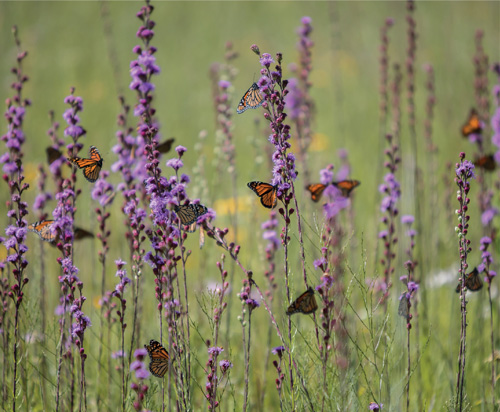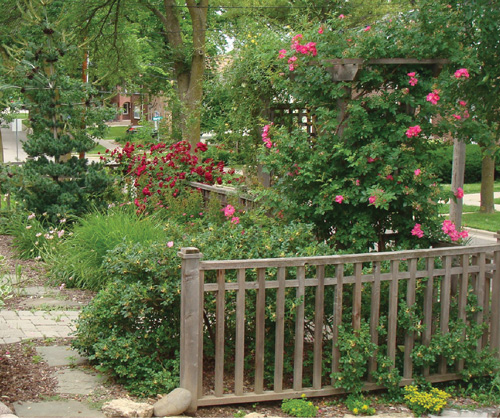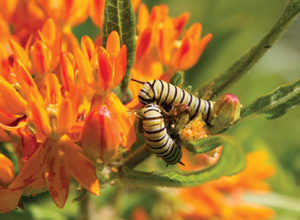Story and photos by Filomena Cimino

The year 2020 was surely challenging—I doubt anyone would deny that—but it did give us an opportunity to reassess many things as we all began spending more time at home. As our houses became our safe havens, we found ourselves either consciously or unconsciously reassessing what “home” meant to each of us. Many caught up on projects like cleaning out and donating possessions we didn’t need and organizing spaces. Some of us grew gardens, both vegetable and decorative. Ah … necessity, that grand mother of invention, perhaps re-invention in this case.
My work as a landscape designer often has me literally grounded in the reality of today’s environmental challenges. Many of us appreciate and marvel at the sublime beauty of nature. We are finally beginning to realize that nature does not exist apart from us. What is required of us instead is that we recognize our integral role, how each one of us can turn the tide and in so doing create a living, sustainable planet for the future. I will elaborate on this a bit using native plants as an example.
The role that native species of plants play in the ecosystem is a strong one. With an alarming number of animal, bird, and plant species threatened with extinction (mostly since 1900), the argument for preservation is strong. For example, most of us are aware of the benefits of the humble bumblebee—without them, simply put, much of our food wouldn’t get pollinated. Two-thirds of the world’s crop species depend on natures creatures to transfer pollen between male and female flower parts. There are many pollinators including birds, butterflies, even bats, but no question—bees are the most important. Their wings beat 130 times per second, and this action, called buzz pollination, vibrates flowers until pollen is released. This behavior helps plants produce more fruit.


So, the next time you consider purchasing insecticide sprays, flea and tick treatments, or chemical products for your vegetable garden or your farm, please think again. Instead, take an active role in our collective well-being. The food chain is a real and dynamic system which we are completely dependent on for survival.
Back to plants. The argument to plant native species is significant, but it should also be recognized that an international mix of species will still engage in ecological processes that are like a naturally occurring community of plants. All species, both native and exotic, occupy specific ecological niches and interact with their environment and the plants around them. We need not completely exclude all plants that are not native. It is very important, however, to identify non-native trees, shrubs, wildflowers, and grasses that are considered invasive that should not be used in landscape plantings. These invasive exotic plants can displace native plant communities and the wildlife populations that they sustain. Their aggressive spread and growth enable them to out-compete native flora, enabling them to form large monocultures. The result is an obvious degradation of natural healthy biological systems. Native plants provide active dynamic landscapes with no loss of aesthetics—and with many more ecologically sound benefits than those that are merely decorative.

Specifically, let’s cite real benefits of native plants:
- Easy to grow! These babies have adapted and evolved here for millennia. They have truly stood the test of time.
- Low maintenance. Everyone asks designers like me for “low maintenance” plants. The natives are the only true low maintenance plants. Why? Because they have adapted to our soils, climates, geology, and exist in harmony with our insect, bird, and mammal populations. Plus, because of these adaptations, they are less disease prone.
- Many flowering natives are favored by native bees and other pollinating insects. That’s a huge benefit to know that you are contributing to the food chain that sustains life on Earth.
- Particular species of forbs (flowering perennials) can be the sole nectar source for a specific butterfly or insect, for example: spotted beebalm (Monarda punctata) for the rare Karner blue butterfly. How special!
- Certain species of forbs, like the cup plant (Silphium perfoliatum) provide several benefits for birds: food, water, and cover. Food for goldfinches (the seeds produced by the plant); water for songbirds and butterflies that will drink after rain from the “cup” that lies at the leaf-stem junction of the plant; and shelter, since the large leaves provide small birds with cover from predators. These are the characteristics of a highly functional plant.
- Deer resistance: Often natives are left untouched by deer. Again, they have an adaptive ecological niche in the landscape where deer have cohabitated.
- Monarch habitat: A monarch butterfly could live its life exclusively on milkweed (Asclepias spp.). We have three native species in central New York. Most monarchs live only three to five weeks. So, for the Monarchs’ return journey to Mexico to occur, the process of the migration takes four generations! These butterflies are facing population decline, so please consider making your gardens Monarch-friendly by adding milkweeds, liatris, purple coneflower (Echinacea purpurea), New York ironweed (Vernonia noveboracensis) and others.
A close friend of mine who, since 1972, has dedicated his life to his native plant nursery in the Midwest, writes: “Planting natives encompasses far more than just doing a good deed for nature—our very existence depends upon it.”
Filomena Cimino of Skaneateles’s Turtle Island Landscapes is a Certified Nursery and Landscape Professional (CNLP) and a Master Gardener with twenty-five years of experience in working with native plants. Find her at turtleislandscapes.com.
Views: 0






